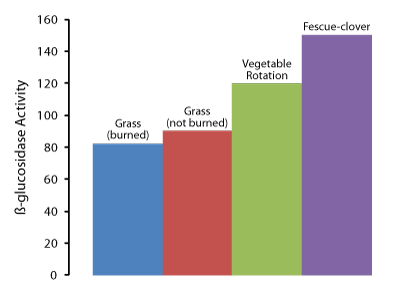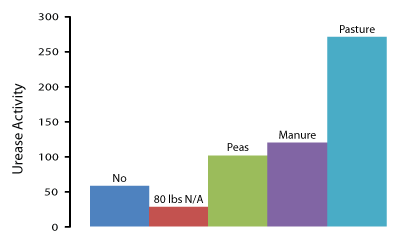Soil Enzymes
What it is: Soil enzymes increase the reaction rate at which plant residues decompose and release plant available nutrients. The substance acted upon by a soil enzyme is called the substrate. For example, glucosidase (soil enzyme) cleaves glucose from glucoside (substrate), a compound common in plants. Enzymes are specific to a substrate and have active sites that bind with the substrate to form a temporary complex. The enzymatic reaction releases a product, which can be a nutrient contained in the substrate.
Sources of soil enzymes include living and dead microbes, plant roots and residues, and soil animals. Enzymes
stabilized in the soil matrix accumulate or form complexes with organic matter (humus), clay, and humus-clay
complexes, but are no longer associated with viable cells. It is thought that 40 to 60% of enzyme activity can come from stabilized enzymes, so activity does not necessarily correlate highly with microbial biomass or respiration. Therefore, enzyme activity is the cumulative effect of long term microbial activity and activity of the viable population at sampling. However, an example of an enzyme that only reflects activity of viable cells is
dehydrogenase, which in theory can only occur in viable cells and not in stabilized soil complexes.
Why it is important: Enzymes respond to soil management changes long before other soil quality indicator changes are detectable. Soil enzymes play an important role in organic matter decomposition and nutrient cycling (see table 1). Some enzymes only facilitate the breakdown of organic matter (e.g., hydrolase, glucosidase), while others are involved in nutrient mineralization (e.g., amidase, urease, phosphatase, sulfates). With the exception of phosphatase activity, there is no strong evidence that directly relates enzyme activity to nutrient availability or crop production. The relationship may be indirect considering nutrient mineralization to plant available forms is accomplished with the contribution of enzyme activity.
| Table 1. Role of soil enzymes | ||||
| Enzyme | Organic Matter Substances Acted On |
End Product | Significance | Predictor of Soil Function |
|---|---|---|---|---|
| Beta glucosidase | carbon compounds | glucose (sugar) | energy for microorganisms | organic matter decomposition |
| FDA hydrolysis | organic matter | carbon and various nutrients |
energy and nutrients for microorganisms, measure microbial biomass |
organic matter decomposition nutrient cycling |
| Amidase | carbon and nitrogen compounds | ammonium (NH4) | plant available NH4 | nutrient cycling |
| Urease | nitrogen (urea) | ammonia (NH3) and carbon dioxide (CO2) |
plant available NH4 | nutrient cycling |
| Phosphatase | phosphorus | phosphate (PO4) | plant available P | nutrient cycling |
| Sulfatase | sulfur | sulfate (SO4) | plant available S | nutrient cycling |
Specific problems that might be caused by poor function: Absence or suppression of soil enzymes prevents or reduces processes that can affect plant nutrition. Poor enzyme activity (e.g., pesticide degrading enzymes) can result in an accumulation of chemicals that are harmful to the environment; some of these chemicals may further inhibit soil enzyme activity.
What you can do: Organic amendment applications, crop rotation, and cover crops have been shown to enhance enzyme activity (figures 1 and 2). The positive effect of pasture (figure 2) is associated with the input of animal manure and less soil disturbance. Agricultural methods that modify soil pH (e.g., liming) can also change enzyme activity.


Figure 2. Effects of management on urease activity (adapted from Bandick and Dick 1999).
For more information go to Soil Management Practices.
Measuring soil enzymes: Enzymes are measured indirectly by determining their activity in the laboratory using biochemical assays. Enzyme assays reflect potential activity and do not represent true in situ activity levels and must be viewed as an index.
When possible, compare the site of interest to samples taken from an adjacent, undisturbed site on the same soil
type. Alternatively, for a newly implemented land management system, track changes from time zero to five
or more years with annual sampling to detect temporal changes in activity of soil enzymes.
Bandick AK and Dick RP. 1999. Field management effects on enzyme activities. Soil Biology and Biochemistry 31:1471-1479.
Dick RP. 1994. Soil Enzyme Activity as an Indicator of Soil Quality. In: Doran JW et al., editors. Defining soil quality for a sustainable environment.. Madison, WI. p107-124.
Tabatabai MA. 1994. Soil Enzymes. In: Weaver RW et al., editors. Methods of soil analysis. Part 2. Microbiological and Biochemical Properties. p 775-833.
